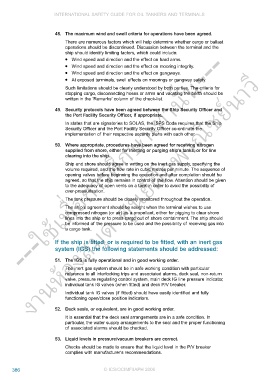Page 420 - International safety guide for oil tankers and terminals
P. 420
INTERNATIONAL SAFETY GUIDE FOR OIL TANKERS AND TERMINALS
48. The maximum wind and swell criteria for operations have been agreed.
---ใช้เพื่อการศึกษาเท่านั้น---
There are numerous factors which will help determine whether cargo or ballast
operations should be discontinued. Discussion between the terminal and the
ship should identify limiting factors, which could include:
Wind speed and direction and the effect on hard arms.
งานห้องสมุด ศูนย์ฝกพาณิชย์นาวี
Wind speed and direction and the effect on mooring integrity.
Wind speed and direction and the effect on gangways.
At exposed terminals, swell effects on moorings or gangway safety.
Such limitations should be clearly understood by both parties. The criteria for
stopping cargo, disconnecting hoses or arms and vacating the berth should be
written in the ‘Remarks’ column of the check-list.
49. Security protocols have been agreed between the Ship Security Officer and
the Port Facility Security Officer, if appropriate.
In states that are signatories to SOLAS, the ISPS Code requires that the Ship
Security Officer and the Port Facility Security Officer co-ordinate the
implementation of their respective security plans with each other.
50. Where appropriate, procedures have been agreed for receiving nitrogen
supplied from shore, either for inerting or purging ship’s tanks, or for line
clearing into the ship.
ึ
Ship and shore should agree in writing on the inert gas supply, specifying the
volume required, and the flow rate in cubic metres per minute. The sequence of
opening valves before beginning the operation and after completion should be
agreed, so that the ship remains in control of the flow. Attention should be given
to the adequacy of open vents on a tank in order to avoid the possibility of
over-pressurisation.
The tank pressure should be closely monitored throughout the operation.
The ship’s agreement should be sought when the terminal wishes to use
compressed nitrogen (or air) as a propellant, either for pigging to clear shore
lines into the ship or to press cargo out of shore containment. The ship should
be informed of the pressure to be used and the possibility of receiving gas into
a cargo tank.
If the ship is fitted, or is required to be fitted, with an inert gas
system (IGS) the following statements should be addressed:
51. The IGS is fully operational and in good working order.
The inert gas system should be in safe working condition with particular
reference to all interlocking trips and associated alarms, deck seal, non-return
valve, pressure regulating control system, main deck IG line pressure indicator,
individual tank IG valves (when fitted) and deck P/V breaker.
Individual tank IG valves (if fitted) should have easily identified and fully
functioning open/close position indicators.
52. Deck seals, or equivalent, are in good working order.
It is essential that the deck seal arrangements are in a safe condition. In
particular, the water supply arrangements to the seal and the proper functioning
of associated alarms should be checked.
53. Liquid levels in pressure/vacuum breakers are correct.
Checks should be made to ensure that the liquid level in the P/V breaker
complies with manufacturer’s recommendations.
386 © ICS/OCIMF/IAPH 2006

